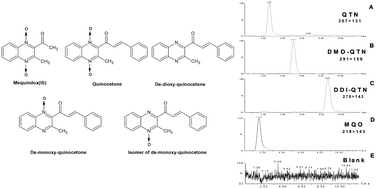Determination of quinocetone and its two major metabolites in chicken liver and muscle tissues by liquid chromatography-tandem mass spectrometry
Abstract
A sensitive and quantitative

* Corresponding authors
a
National Center of Biomedical Analysis, 27 Taiping Road, Beijing 100039, People's Republic of China
E-mail:
dft@proteomics.cn
b The Institute of Hygiology and Environmental Medical Research, Academy of Military Medical Sciences, Tianjin 300050, People's Republic of China
A sensitive and quantitative

 Please wait while we load your content...
Something went wrong. Try again?
Please wait while we load your content...
Something went wrong. Try again?
J. Fang, Y. Li, S. Wu, K. Ma, H. Li, Z. Gao and F. Dong, Anal. Methods, 2012, 4, 1149 DOI: 10.1039/C2AY05883A
To request permission to reproduce material from this article, please go to the Copyright Clearance Center request page.
If you are an author contributing to an RSC publication, you do not need to request permission provided correct acknowledgement is given.
If you are the author of this article, you do not need to request permission to reproduce figures and diagrams provided correct acknowledgement is given. If you want to reproduce the whole article in a third-party publication (excluding your thesis/dissertation for which permission is not required) please go to the Copyright Clearance Center request page.
Read more about how to correctly acknowledge RSC content.
 Fetching data from CrossRef.
Fetching data from CrossRef.
This may take some time to load.
Loading related content
